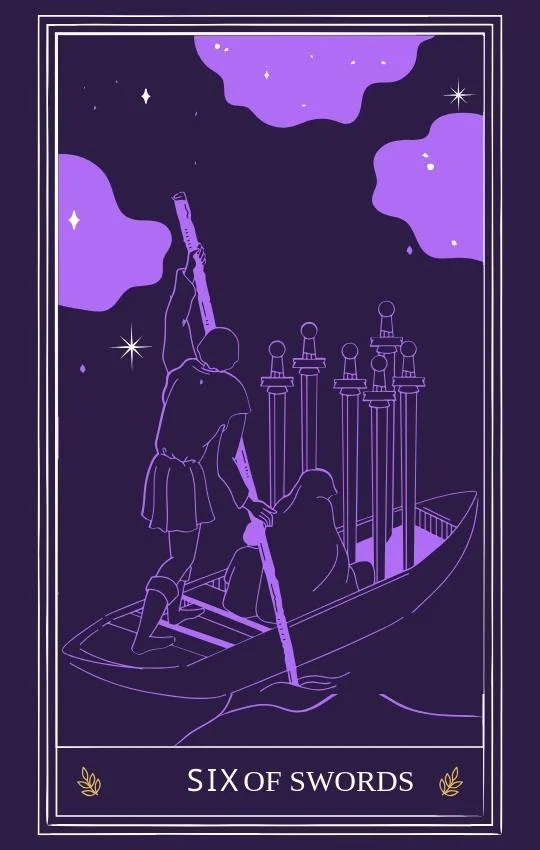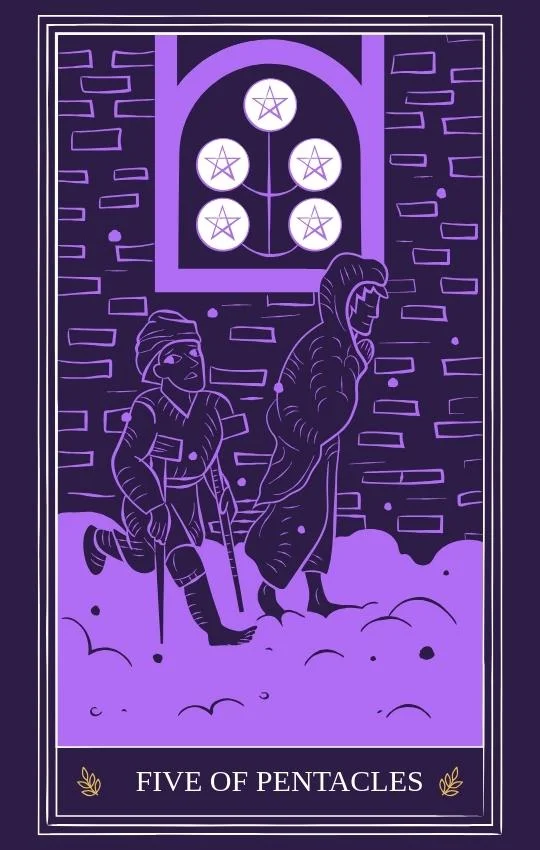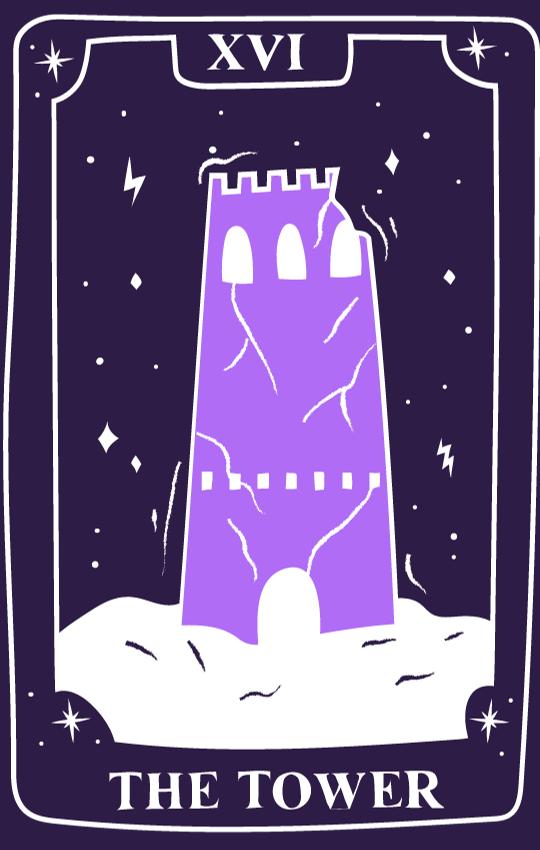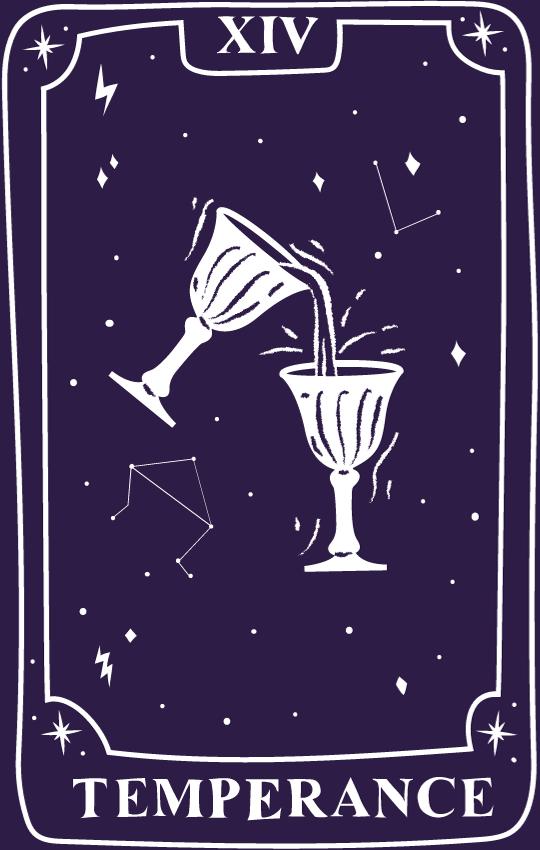
The Devil Tarot card conveys the domain of forbidden aspects—the untamed and unacknowledged shadow within our subconscious that society rejects. This shadow, residing at the core of our essence, persists beyond attempts to eliminate or control it. In its earliest depictions, symbolized as a vampire-demon, The Devil instilled a fear, propagated by the church, of individuals potentially surrendering their souls to unrestrained and passionate forces.
The Devil’s representation evolved in the mid-1700s, presenting a more refined portrayal—the “scapegoated goddess” known esoterically as Baphomet. Fueled by potent reservoirs of passion and primal desires, she endeavours to break free from the constraints of stereotypical roles and attain genuine soul liberation.
Symbolism And Meaning Of The Devil Tarot Card
The Devil card in the Tarot deck is a complex and multi-faceted symbol that often elicits strong reactions due to its name and imagery. Here are key symbols and meanings associated with the Devil card:
Reversed Meaning Of The Devil Card
When the reversed Devil card appears, it implies that you derive pleasure from instigating disorder and opposition without any discernible or constructive purpose. Your sense of humor may exhibit a somewhat warped quality, driven by motives of vengeance or a penchant for being deliberately bothersome.
It’s essential to rein in the juvenile and mischievous tendencies within you before they lead to more serious consequences. Put a check on those impulses and work towards redirecting your behavior away from this heedless path. Despite the momentary amusement, such antics can have enduring repercussions that are worth considering in the long term.
Conclusion
The guidance from the Devil card suggests embracing a bold approach. In this scenario, subtlety or strategic manoeuvres may not yield any benefits. Instead, assert your agenda, communicate openly, and be prepared for the consequences. It might be advantageous to convey your authentic emotions, even if they involve expressions of anger. Recognise and accept the full range of your feelings, understanding that while acting on every emotion might not be necessary, acknowledging and embracing your inner experiences allows you to stay true to yourself.

About Author
Hello, I’m Sonami Kumar, a multifaceted individual with a passion for exploring the realms of spirituality and self-discovery. Currently pursuing an MBA, I am immersed in the intricacies of business and management. Beyond the boardrooms and textbooks, however, lies my profound connection to spiritual practices and holistic healing. As a healer, I am dedicated to facilitating emotional, physical, and spiritual well-being, guiding individuals on their journeys toward inner balance and harmony.
Tarot reading is a cherished aspect of my life, where intuition and symbols come together to reveal understanding and possibilities of various aspects of life. Each card drawn is a pathway to self-discovery and enlightenment, providing a unique perspective on one’s journey. My journey is a testament to the transformative power of holistic living, inviting others to embrace the magic within themselves and the universe.
Tarot cards are a deck of 78 cards used for divination, self-reflection, and gaining insight into various aspects of an individual’s life. Each card in the Tarot deck has its own unique symbolism, representing different archetypes and universal themes. The deck is divided into two main sections: the Major Arcana and the Minor Arcana. The Major Arcana consists of 22 cards, each depicting a significant life event or lesson. These cards often signify major shifts or transformations in one’s journey. The Minor Arcana consists of 56 cards categorized into four suits: Cups, Wands, Swords, and Pentacles. These suits represent emotions, actions, thoughts, and material aspects respectively. Tarot readings involve drawing a certain number of cards from the deck in response to specific questions or situations raised by the seeker. Each card interpretation is influenced by the reader’s intuitive abilities as well as established meanings associated with different symbols within the Tarot tradition. Overall, tarot cards act as powerful tools for introspection and guidance that can help individuals explore their past experiences, present challenges, and future possibilities in a profound manner.
Tarot cards are a tool used in divination to gain insights into an individual’s past, present, and future. The effectiveness of tarot cards lies in the interpretation of its symbols and archetypes. Each tarot deck consists of 78 cards classified into two main groups: Major Arcana and Minor Arcana. Major Arcana represents significant life events and transformative experiences, while Minor Arcana reflects everyday situations and challenges. When a reading is conducted, the reader shuffles the deck while focusing on a specific question or topic provided by the querent. The reader then draws cards from the deck, placing them in specific positions forming spreads like Celtic Cross or Three-Card Spread. Based on established meanings associated with each card’s symbolism and position within the spread, the reader provides interpretations that guide individuals towards self-reflection, uncovering hidden aspects of their lives, and potentially even influencing their decision-making process. However, it is vital to note that tarot cards do not predict exact futures but rather offer guidance by tapping into one’s subconscious mind and intuition.
Tarot card reading is a skill that can be developed by anyone, but possessing special abilities can enhance the accuracy and depth of the readings. While anyone can learn the meanings of the cards and interpret their symbolism, it takes dedication, practice, and intuition to become a proficient tarot reader. Understanding the intricate connections between different cards, mastering various spreads, and learning to tap into one’s intuition are crucial aspects of this craft. However, having special abilities such as heightened intuition or psychic awareness can provide an added layer of insight and clarity to the readings. Skilled tarot readers are not only able to interpret the cards but also possess perceptive skills to understand hidden meanings, emotions, and energies within each reading. Therefore, while tarot card reading can be learned by anyone willing to invest time and effort into mastering it, individuals with natural intuitive abilities may have an advantage in delivering more profound and accurate interpretations for their clients.
In a tarot deck, each card holds its own unique significance and contributes to the overall message and guidance provided by the reading. The significance of each card is derived from a combination of its symbolic imagery, historical context, and the intuitive interpretation of the reader. Major arcana cards represent major life events or spiritual lessons and offer profound insights into one’s personal journey. These cards often highlight themes such as love, transformation, or personal growth. On the other hand, minor arcana cards delve into more specific areas of life such as relationships (Cups), intellect (Swords), emotions (Pentacles), or actions (Wands). While interpretations may vary slightly depending on the deck used or the reader’s expertise, understanding the significance of each card is vital in facilitating meaningful tarot readings that reflect on past experiences, provide insight into present circumstances, and shed light on potential future outcomes.
In order to learn to interpret tarot cards effectively, one must initially develop a strong foundation of knowledge regarding the symbolism and meanings associated with each card. This entails studying various tarot decks and their respective interpretations, along with delving into the rich history and tradition of tarot reading. Familiarity with numerology, astrology, and other mystical systems can also enhance one’s understanding of the cards’ significance. Additionally, regular practice is essential for honing interpretation skills. Engaging in guided readings, either with a mentor or through self-reflection exercises, helps individuals unlock their intuition while simultaneously deepening their insight into the cards’ messages. It is equally crucial to approach tarot reading with an open mind and a non-judgmental attitude towards oneself and others. By integrating these elements – knowledge acquisition, practice, intuition cultivation, and emotional sensitivity – an individual can master the art of interpreting tarot cards proficiently for fruitful guidance in professional settings.
Tarot card readings have long been a subject of debate regarding their accuracy and true purpose. While some skeptics dismiss them as mere entertainment, many professional tarot readers argue otherwise. Tarot cards are believed to tap into the subconscious mind’s vast wisdom and provide insights into various aspects of one’s life. Experienced practitioners maintain that the accuracy of these readings heavily relies on the reader’s expertise, intuitive abilities, and knowledge of symbolism linked to each card. A skilled tarot reader uses their acumen to interpret the cards’ meaning in relation to an individual’s specific situation or inquiry. It is essential, however, to approach tarot readings with an open mind and understand that they offer guidance rather than absolute predictions. Therefore, it is inaccurate to label tarot card readings solely as entertainment; instead, they should be regarded as a powerful tool for introspection and personal growth when approached with sincerity and respect.
Tarot cards, widely recognized as a divination tool, raise the intriguing question of whether they possess the ability to predict the future. From a professional standpoint, it is important to examine this matter objectively. Tarot cards do not have any inherently magical powers or abilities; instead, they serve as a visual aid for tapping into one’s intuition and subconscious mind. The interpretation of tarot cards relies heavily on the reader’s skills and experience, as well as their empathic connection with the querent. While tarot can provide insights into a person’s present situation and shed light on potential outcomes based on current circumstances, it is crucial to acknowledge that predictions are not set in stone but rather subject to change due to human agency and external factors. Therefore, tarot cards should be approached as a valuable tool for introspection, self-reflection, and gaining perspective rather than an infallible method for predicting future events.
There are indeed different types of tarot decks available, each with its own unique characteristics and symbolic elements. The most commonly used tarot deck is the Rider-Waite-Smith (RWS) deck, which was designed in the early 20th century by Arthur Edward Waite and artist Pamela Colman Smith. This deck consists of 78 cards, divided into major arcana cards representing significant life events and minor arcana cards reflecting day-to-day experiences. Another popular type is the Marseille Tarot, which originated in France during the 16th century. This deck typically features simple artwork with vibrant primary colors and lacks the pictorial scenes found in RWS decks. Additionally, there are various other decks that cater to specific interests or cultural perspectives, such as the Thoth Tarot developed by Aleister Crowley and Lady Frieda Harris for those inclined towards occultism, or decks focused on feminist themes or specific mythological systems. Each of these tarot decks offers its own interpretation and symbolism that users can leverage based on their personal preferences or intentions during readings.
One common misconception about tarot cards is that they are purely used for fortune-telling or predicting the future. In reality, tarot cards serve as a tool for self-reflection, personal growth, and gaining insight into one’s own subconscious mind. They can provide guidance and support in decision-making processes by helping individuals uncover subconscious patterns, beliefs, and emotions that may be influencing their current situation. Another misconception is that tarot readers possess supernatural abilities and have direct access to hidden knowledge. In truth, tarot readers interpret the symbolism of the cards based on their knowledge of mythology, psychology, and universal archetypes. Their interpretations are subjective and open to individual interpretation. It is essential to approach tarot with an open mind, understanding that its value lies in its ability to facilitate introspection rather than predict specific events with absolute certainty.
In the realm of tarot card reading, the belief in spiritual practices or supernatural powers is not a necessary prerequisite for effectively using tarot cards. Tarot cards have evolved to become a tool that can be utilized by anyone with dedication and practice, irrespective of their personal beliefs. While some individuals may incorporate spiritual practices into their tarot readings, such as meditation or connecting with higher energies, this is a matter of personal choice rather than a necessity. At its core, tarot card reading relies on symbolism, intuition, and interpretation skills. Through study and experience, one can learn how to interpret the imagery and messages conveyed by the cards. By honing their intuitive abilities, practitioners can tap into their own deep understanding and insight while utilizing tarot cards as a guide. Ultimately, it is an individual’s commitment to learning and growing in their craft that determines the effectiveness of their use of tarot cards, regardless of any spiritual beliefs they may hold.














































































